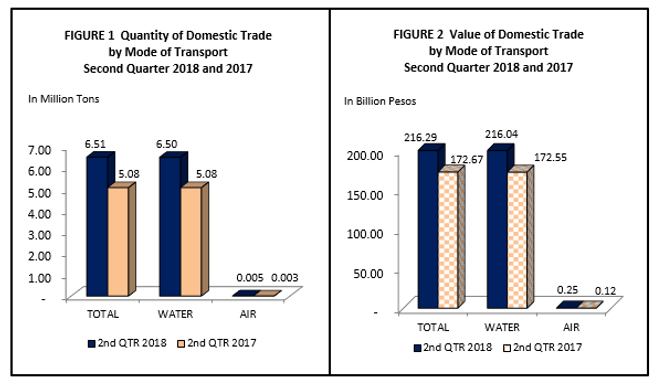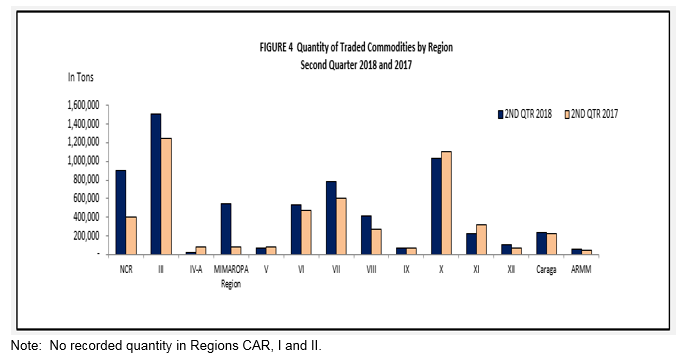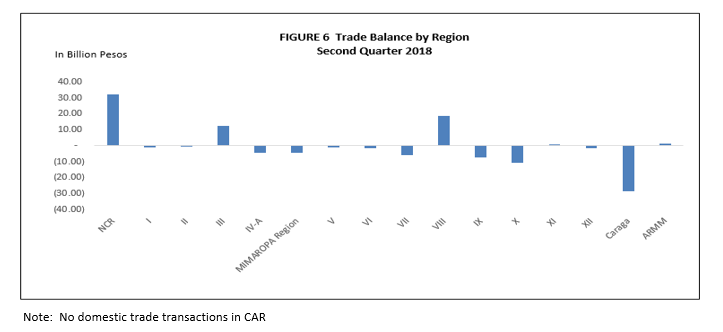Quantity and Value of domestic trade increases
The total quantity of domestic trade during the second quarter of 2018 registered a 6.51 million tons, up by 28.1 percent from its level of 5.08 million tons in the same quarter of 2017. Mineral fuels, lubricants and related materials commodities led in terms of quantity with 1.50 million tons or 23.1 percent share to total quantity of domestic trade. Animal and vegetable oils, fats and waxes commodities had the least quantity with only 0.02 million tons. (Figure 1)
Similarly, value of domestic trade up by 25.3 percent with value amounting to PHP216.29 billion in the second quarter of 2018 from PHP172.67 billion in the second quarter of 2017. (Figure 2)
Almost all of the commodities were traded through water (coastwise) while the remaining were traded through air.

Machinery and Transport equipment commodities account for 34.4 percent of total value of traded commodities
Machinery and transport equipment topped, in terms of value, during the second quarter of 2018 amounting to PHP74.40 billion or 34.4 percent of the total value of domestic trade. These commodities have also shared 39.3 percent of the total traded commodities in the previous year of same quarter. Food and live animals posting a value of PHP49.15 billion and manufactured goods classified chiefly by material with a value amounting to PHP31.16 billion, placed second and third, respectively. Completing the top ten commodity sections, in terms of value for the second quarter of 2018 were the following:
• Mineral fuels, Lubricants and related materials, PHP16.90 billion;
• Miscellaneous manufactured articles, PHP13.03 billion;
• Chemical and related products n.e.c., PHP12.34 billion;
• Beverages and Tobacco, PHP9.14 billion;
• Commodities and transactions n.e.c., PHP5.69 billion;
• Crude materials, inedible except fuels, PHP3.76 billion; and
• Animal and vegetable oils, fats and waxes, PHP619.02 million

Central Luzon contributes 23.2 percent of the total quantity of traded commodities
Among the regions, Central Luzon posted the highest quantity of traded commodities with 1.51 million tons during the second quarter of 2018. Northern Mindanao and National Capital Region followed with 1.03 million tons and 0.90 million tons, respectively. Other regions recorded the following quantities:
• Central Visayas, 0.78 million tons;
• MIMAROPA Region, 0.55 million tons;
• Western Visayas, 0.53 million tons;
• Eastern Visayas, 0.42 million tons;
• Caraga, 0.24 million tons;
• Davao Region, 0.23 million tons;
• SOCCSKSARGEN, 0.11 million tons;
• Zamboanga Peninsula, 0.07 million tons;
• Bicol Region, 0.07 million tons;
• ARMM, 0.05 million tons; and
• CALABARZON, 0.02 million tons.

Outflow and Inflow value of traded commodities grow in the second quarter of 2018
Outflow refers to the total value of commodities which goes out of the specified region or province while Inflow refers to the total value of commodities coming in the specified region. Trade balance is the difference between the outflow and inflow.
Total outflow and inflow value in the second quarter of 2018 totaled to PHP216.29 billion. This translates to an increase of 25.3 percent from PHP172.67 billion recorded in the same quarter of 2017. NCR showed the highest outflow value amounting to PHP59.43 billion or 27.5 percent from the total outflow among the regions. Central Visayas and Eastern Visayas followed with PHP34.15 billion and PHP30.47 billion, respectively.
In terms of inflow value, Central Visayas had the highest value amounting to PHP39.77 billion or 18.4 percent share to the total inflow in the second quarter of 2018. Cagayan Valley posted the lowest inflow value amounting to PHP2.70 million.

NCR tops favorable trade balance
Five regions (5) posted positive trade balances in the second quarter of 2018. National Capital Region ranked first with trade balance of PHP32.04 billion. It was followed by Eastern Visayas with trade balance amounting to PHP18.86 billion. Other regions that recorded a positive trade balance were the following:
• Central Luzon, PHP12.42 billion;
• ARMM, PHP1.49 billion, and
• Davao Region, PHP807.03 million.
In contrast, eleven regions (11) with unfavorable (negative) trade balance during the second quarter of 2018 were the following:
• Caraga, PHP28.26 billion;
• Northern Mindanao, PHP10.75 billion;
• Zamboanga Peninsula, PHP7.15 billion;
• Central Visayas, PHP5.62 billion;
• CALABARZON, PHP4.61 billion;
• MIMAROPA, PHP4.20 billion;
• Western Visayas, PHP1.48 billion;
• SOCCSKSARGEN, PHP1.26 billion;
• Bicol Region, PHP1.06 billion;
• Ilocos Region, PHP965.96 million; and
• Cagayan Valley, P269.74 million

EXPLANATORY NOTES
Introduction
Commodity flow or domestic trade statistics is a compilation of data on commodities carried through the air, rail, and water transport systems in the country.
The Philippine Statistics Authority (PSA) compiles domestic trade statistics from copies of coasting manifests and coastwise passenger manifest collected from the Philippine Ports Authority (PPA) and copies of airway bills from Philippine Airlines to generate Commodity Flow or Domestic Trade Statistics. Coasting manifests were collected from major ports and other active seaports listed by the PPA all over the country to account for transactions that went through seaports.
Data on the inflow and outflow of commodities in the different regions of the country are used to construct inter-regional and inter-industry relation tables.
All copy of documents are compiled and processed by the provincial statistical offices. Final data review of the data files, generation of statistical tables, and preparation of Special Releases are done at the Trade Statistics Division (TSD).
The 1993 Philippine Standard Commodity Classification (PSCC) is used to classify the commodities at the 5-digit level (item) for coastwise statistics and 3-digit level (group) for air statistics for statistical purposes.
All documents received as of 15 September 2018 were processed and included in the generation of 2018 Second Quarterly statistical tables. However, documents received after the deadline are included in the final tabulation.
DOMSTAT reports from the following provinces/cities which are not yet received as of 15 September 2018 and thus, are not included in this Special Release:
|
Province |
Mode of Transport |
Month (2nd Quarter 2018) |
|---|---|---|
| a. NCR |
Air |
June 2018 |
|
b. Masbate |
Coastwise | April & May 2018 |
Detailed data on domestic trade statistics are available at the Trade Statistics Division (TSD) - Economic Sector Statistics Service (ESSS) with telephone number: 376-19-75.
Limitations of Domestic Trade Statistics
The domestic trade statistics contained in this report pertains to the flow of goods through airports and seaports in the country, whether for government or private use, or for commercial purposes. Domestic trade through land was excluded because of an absence of an approach to data in the archipelagic island of the country. Moreover, data on rail transport are also excluded.
Air waybills, on the other hand, were collected from the Philippine Airlines accounting for transactions that passes through all airports.
Goods and/or commodities that were excluded in the compilation of data are:
a. Goods transported by vessels of the Philippine Navy.
b. Fish and other marine products landed directly from the sea.
c. Service cargoes for consumption of the vessel crew.
d. Cadaver
